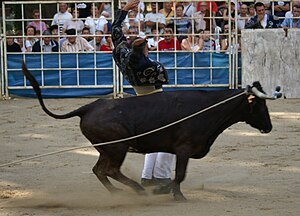
A running of the bulls is an event that involves running in front of a small group of bulls, typically six but sometimes ten or more, that have been let loose on sectioned-off streets in a town, usually as part of a summertime festival. Particular breeds of cattle may be favored, such as the toro bravo in Spain, also often used in post-run bullfighting, and Camargue cattle in Occitan France, which are not fought. Bulls are typically used in such events.
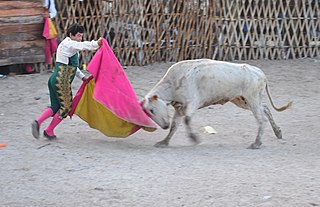
A bullfighter is a performer in the activity of bullfighting. Torero or toureiro, both from Latin taurarius, are the Spanish and Portuguese words for bullfighter and describe all the performers in the activity of bullfighting as practised in Spain, Portugal, Mexico, Peru, France, Colombia, Ecuador, Venezuela and other countries influenced by Portuguese and Spanish culture. The main performer and leader of the entourage in a bullfight, and who finally kills the bull, is addressed as maestro (master), or with the formal title matador de toros. The other bullfighters in the entourage are called subalternos and their suits are embroidered in silver as opposed to the matador's gold. They include the picadores, rejoneadores, and banderilleros.
The County of Armagnac, situated between the Adour and Garonne rivers in the lower foothills of the Pyrenées, was a historic county of the Duchy of Gascony, established in 601 in Aquitaine. In 960, the title of 'Count of Armagnac' was established, and thus the County of Armagnac was created. In 1751, following the death of childless Charles de Lorraine, Comte d'Armagnac, the county was absorbed into the Crown lands of France and the King, then Louis XV took the title of 'Count of Armagnac'. In 1791, following the Decree dividing France into departments, the county was disestablished, but remains an important natural region of France.

Bull-leaping is a term for various types of non-violent bull fighting. Some are based on an ancient ritual from the Minoan civilization involving an acrobat leaping over the back of a charging bull. As a sport it survives in modern France, usually with cows rather than bulls, as course landaise; in Spain, with bulls, as recortes and in Tamil Nadu, India with bulls as Jallikattu.

A bullring is an arena where bullfighting is performed. Bullrings are often associated with the Iberian Peninsula, but they can also be found through Iberian America and in a few Spanish and Portuguese ex-colonies in Africa. Bullrings are often historic and culturally significant centres that bear many structural similarities to the Roman amphitheatre.

The Spanish Fighting Bull is an Iberian heterogeneous cattle population. It is exclusively bred free-range on extensive estates in Spain, Portugal, France and Latin American countries where bull fighting is organized. Fighting bulls are selected primarily for a certain combination of aggression, energy, strength and stamina. In order to preserve their natural traits, during breeding the bulls rarely encounter humans, and if so, never encounter them on foot.

Spanish-style bullfighting is a type of bullfighting that is practiced in Spain, Mexico, Colombia, Ecuador, Venezuela, Peru, as well as in parts of southern France and Portugal. This style of bullfighting involves a physical contest with humans attempting to publicly subdue, immobilize, or kill a bull. The most common bull used is the Spanish Fighting Bull, a type of cattle native to the Iberian Peninsula. This style of bullfighting is seen to be both a sport and performance art. The red colour of the cape is a matter of tradition – bulls are color blind. They attack moving objects; the brightly-colored cape is used to mask blood stains.

Fourcès is a commune in the Gers department in the Occitanie region in southwestern France known for its circular square.
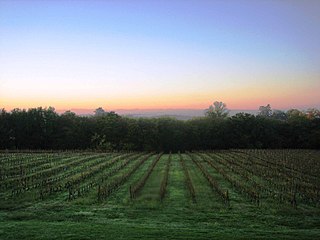
Castelnau-d'Auzan is a former commune in the Gers department in southwestern France. On 1 January 2016, it was merged into the new commune Castelnau-d'Auzan-Labarrère.
The canton of Montréal is a former administrative division in the Gers department, which is itself a component of the region Occitanie, in the area formerly called Gascony, France. It had 4,967 inhabitants (2012). It was disbanded following the French canton reorganisation which came into effect in March 2015. It consisted of nine communes, which joined the canton of Armagnac-Ténarèze in 2015.

Bovine sports are sports that involve cattle, commonly a bull, ox, steer, cow or calf.
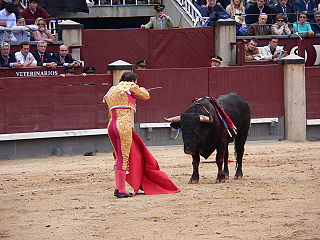
Bullfighting is a physical contest that involves a bullfighter attempting to subdue, immobilize, or kill a bull, usually according to a set of rules, guidelines, or cultural expectations.
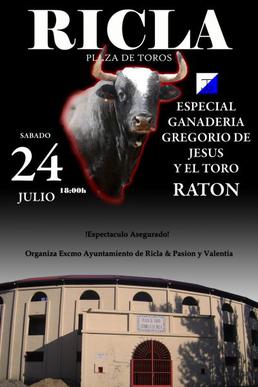
Ratón was a Spanish fighting bull that was nicknamed el toro asesino, el sangriento toro Raton and el terrible Ratón for killing three people in bullfighting rings in Spain during 2006–2011 and injuring thirty more. The bull became legendary in Spain due to the large number of gorings for which he was responsible. Bullfighting fans regarded him as a star and traveled from across the country to see the morlaco at his home at Sueca near Valencia. Matador Jesús Esteve said of Ratón: "He is a killer. He is lazy, he doesn't want to participate. He does his own thing, waiting for somebody to make a mistake. And then when he gets you, he wallops you, and he doesn't let up."

Bull running was a custom practised in England until the 19th century. It involved chasing a bull through the streets of a town until it was weakened, then slaughtering the animal and butchering it for its meat. Bull running became illegal in 1835, and the last bull run took place in Stamford, Lincolnshire, in 1839. The practice was not confined to any particular region, with bull runs also documented at Axbridge in the south west, Canterbury and Wokingham in the south east, Tutbury in the midlands, and Wisbech in the east.

Julio Aparicio Díaz, also known as Julito Aparicio, is a Spanish bullfighter from Seville. Aparicio made his public début in bullfighting at the age of fourteen in 1984. He was confirmed as a torero, or matador, in 1994.
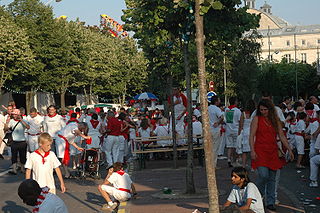
A feria is an annual local festival in Spain and southern France, characterized by bullfights, bull running in the streets, bodegas and bandas. The word festayre means ferias' partiers.

The cuisine of Gascony is one of the pillars of French cuisine. Its originality stems from its use of regional products and from an age-old tradition, typical of the Aquitane and the Midi-Pyrenees, of cooking in fat, in particular goose and duck fat, whereas the cuisine of the south of France favours frying in oil and the cuisine of Normandy contains more dishes that are simmered or cooked in butter. The long life expectancy of Gascons, despite a rich diet, is a classic example of the French paradox.

The siege of Tartas in Gascony was an engagement between English and French forces in the late stages of the Hundred Years' War. It was undertaken by English forces and their Gascon subjects against Charles II of Albret, a powerful nobleman in southwestern France. Albret was hostile to the English and his presence in Gascony caused much trouble to the English in the region, thereby raising the need to strike against him. The bulk of hostilities only lasted up until early 1441: the siege had dragged on inconclusively, and peace terms were agreed between the attackers and defenders. The ceasefire was extended several times until mid-1442 as both sides awaited further support from England and France.
Pablo Lozano Martín, commonly known as La Muleta de Castilla, was a Spanish bullfighter and fighting bull cattle rancher, owner of cattle raising Alcurrucén and "Hermanos Lozano".
Robert Castagnon was an armagnac producer, publisher and founder of Circuit Paul Armagnac. He died in August 2004 at the age of 84 following a car crash.
